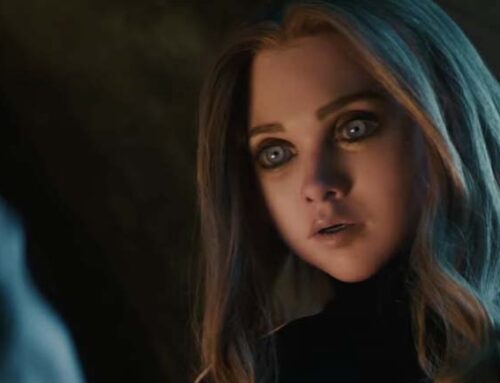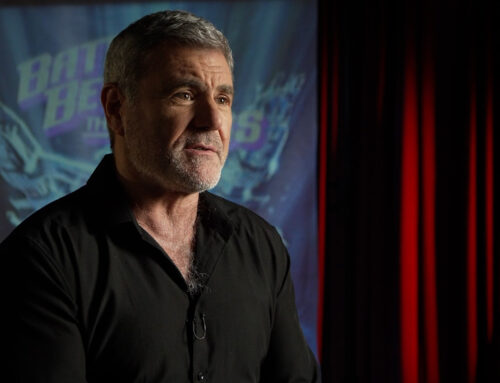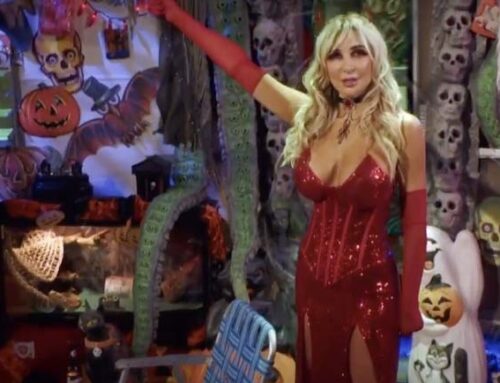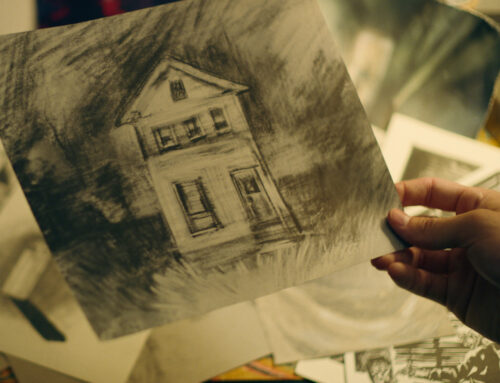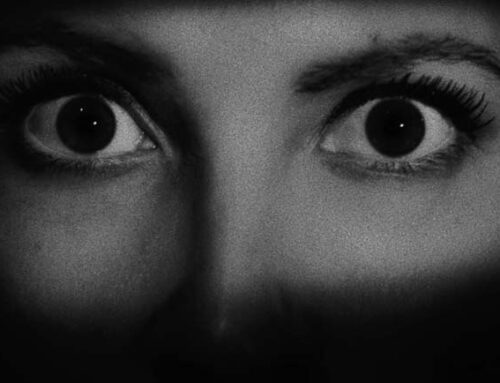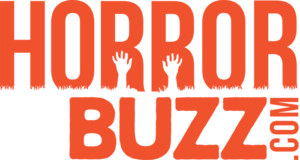Have you heard of the new movie The Scroll of Morlok? Of course, you haven’t. Unless you are a friend or relative of the makers of this little independent horror short, you may be wondering what it might be. Well, it’s a pretty ambitious indie project that really kind of fascinated us when it was sent our way.
Synopsis: A film enthusiast discovers and projects a long-lost silent horror classic film, only to inadvertently free a ‘fictional’ supernatural villain from his celluloid prison.
Think The Purple Rose of Cairo meets Nosferatu and you have an idea of what the filmmakers are trying for. They are in post-production now and are still looking for funding to complete the picture. The filmmakers reached out and we were honestly so taken with the idea, and what is more, the ambition, that we asked them a few questions. Here we are speaking with co-writer-director Dash Finley.
Contribute to their Seed and Spark HERE!
HorrorBuzz: What provoked the spark that created The Scroll of Morlok?
Dash Finley: There were two elements at play when my writing and directing partner Evan and I sat down to come up with this concept. The first was creative — we wanted to pay homage to the seminal works of expressionist horror from the 1920s that had influenced us so much as filmmakers and repurpose them in a fresh and exciting way. I think that, specifically with millennial audiences, there’s a temptation to write off cinema from before a certain year as this creaky, silly relic with no contemporary relevance. We both firmly disagreed and we wanted to show our peers why these movies are so effective, not just for their time, but also today. That was always the seed of the idea. The second component was thinking critically about trying to make a film that could really find an audience and get seen beyond our bubble of friends. Over the past few years, there have been a number of high-concept, visually-driven horror shorts that managed to get serious industry attention, like David Sandberg’s Lights Out, Lars Klevberg’s Polaroid, and Michael Chaves’ The Maiden. We wanted to find a way to take that same path, while also staying true to what we love and our own idiosyncratic style.
 HB: This is a pretty ambitious concept. In writing the script, did you write it with any budgetary constraints in mind or was it a blue sky concept that you just went with?
HB: This is a pretty ambitious concept. In writing the script, did you write it with any budgetary constraints in mind or was it a blue sky concept that you just went with?
DF: Our initial stab at the script was a bit larger scale and even more ambitious than what we ended up shooting. But we soon realized that some of the extremely elaborate visual gags we had planned would not be possible given the budget we had to work with. That said, there was something really creatively dynamic about having to find novel solutions within these narrow boundaries. Honestly, the pared down and simplified version of the story that we had to come up with is so much more dramatically cogent and powerful than the first iteration, and its mostly because we had to think so long and hard about every single visual choice. We managed to accomplish what we wanted while not going broke, so at the end of the day, I chalk that up as a victory.
HB: So you write this script and then what? Was it easy to find people to get in on the project?
DF: It’s been a very long process to assemble this crew. It all started with our incredible producer, Gina Yull, who had worked on a feature project that a friend of mine directed. She came highly recommended and with good reason — she’s a superstar. From there, she put us in touch with a really wonderful assortment of people, many of whom come from her alma mater of Chapman University, and they’ve all been great. Our casting director Jamie Ember has also been a godsend. She found Dyson Posey to play Morlok, who truly couldn’t be more perfect for the role. He’s got these expressive eyes that really feel like a star of some lost Weimar era horror film. Then, she also brought our material to Rae Gray, who we were lucky to have sign on since she’s an extremely accomplished performer in her own right. And she absolutely knocked our socks off. She is essentially giving a silent performance as Kelly, the projectionist who’s stalked by Morlok, and she just brought this raw intensity and intuitiveness to the role. We’ve really been blessed by being surrounded with such talented people.
 HB: What is it that makes Silent film so inherently creepy and difficult to believably replicate with modern equipment?
HB: What is it that makes Silent film so inherently creepy and difficult to believably replicate with modern equipment?
DF: Despite all these huge advances in technology, recent horror films have not been able to replicate the kind of otherworldly quality conjured up by those early classics. As we see it, this haunting “feel” is partially due to a subconscious awareness on the part of the viewer that everyone involved in the making of these films is now dead. It was this morbid realization that set the idea for this short in motion: a silent film that is literally haunted by its ghoulish leading man. To realize our vision, we hope to boil down the most “alien” elements of a 1920s silent film— the crackling silence, unnaturally stilted movements, the high contrast black and white cinematography— and bring them into the 21st century. We shot the entire silent portion against huge green screens, then processed the image digitally to give it that grainy look, while compositing in originally designed matte paintings as the backdrops.
HB: Did the actors have to study any films from the silent era, in particular, to create the ‘film’ within the film?
DF: Yes! I sent our Morlok, Dyson, as well as our wonderful cinematographer Monty Sloan, several classic silent films for reference,. They included Nosferatu, The Cabinet of Dr. Caligiari, The Man Who Laughs, and the 1915 French serial Les Vampires
HB: So you have the Silent Film portion done. What is next?
DF: We have actually filmed both sections of the film — the modern day portion was shot two weeks ago at LA’s historic Velaslavasay Panorama theater, and it went extremely well! But we still need to raise funds in order to complete the extensive post-production process, while will include hiring a colorist, a composer, and a visual effects artist, among other costs. You can find the link to our Seed & Spark campaign here: https://www.seedandspark.com/dashboard/project/the-scroll-of-morlok#overview We’re already seventy percent of the way to our goal with two weeks left, so even a small donation could make a big difference in getting past this final hurdle.

HB: When do you hope to have the film completed if all goes as planned?
DF: Ideally, we’d like to have a finished cut of the film by August.
HB: What advice would you give other filmmakers with similar projects?
DF: Trust your gut and go with your instinct. Don’t listen to nay-sayers, but still remain open to constructive feedback. You’ll probably be discouraged by set-backs (as they’re bound to arise), but don’t let them stop your progress. We wrote this script in January of 2017, and it’s only just now been realized. So the lesson, trite though it may be, is to never give up!
There you have it. Indie horror filmmakers with a cool idea still need a little bit more help. If you can, pop over and contribute. If you can’t then be sure to go see it when it arrives on the festival circuit.


